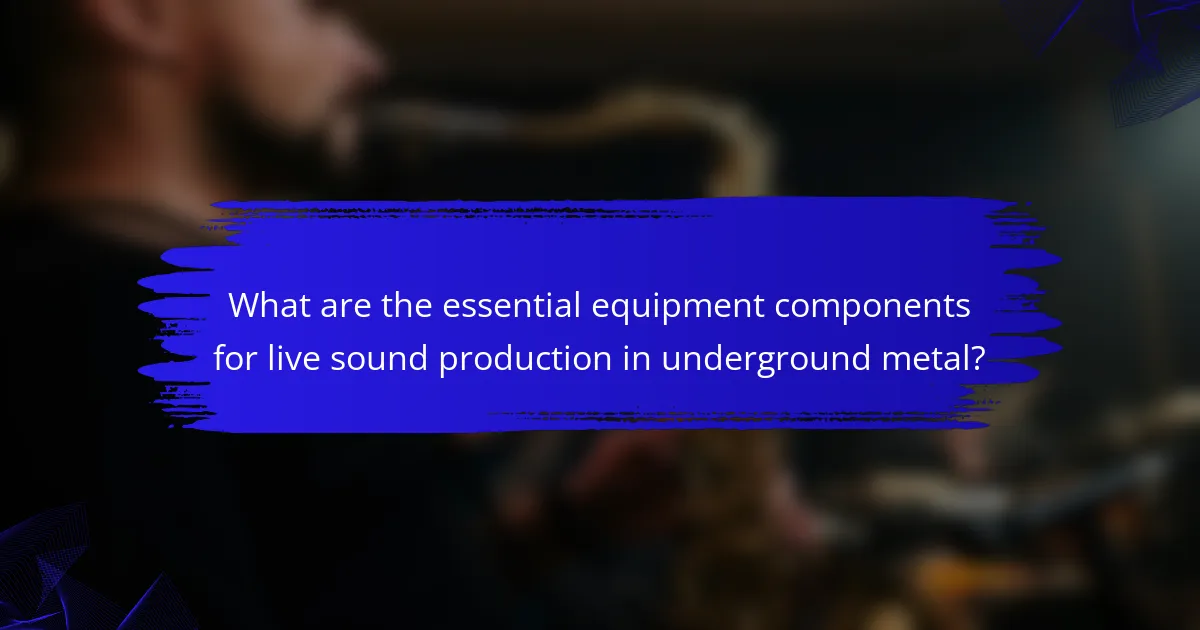Live sound production for underground metal presents unique challenges, including budget constraints and venue limitations. Essential equipment includes powerful amplifiers, high-quality microphones, and effective PA systems. Techniques like dynamic range compression and equalization enhance sound clarity. Understanding venue acoustics and collaborating with local technicians can further optimize performances.

What are the essential equipment components for live sound production in underground metal?
Essential equipment components for live sound production in underground metal include powerful amplifiers, high-quality microphones, robust mixing consoles, and effective PA systems. These elements ensure clear sound reproduction and can handle the genre’s intensity.
Key components are:
1. Amplifiers | Deliver sufficient power to drive speakers effectively.
2. Microphones | Capture vocals and instruments accurately, often dynamic or condenser types.
3. Mixing Consoles | Allow sound engineers to balance levels and effects live.
4. PA Systems | Project sound clearly across venues, essential for audience engagement.
5. Monitors | Provide real-time sound feedback to performers on stage.
6. Cables and Accessories | Ensure reliable connections and minimize signal loss.
Utilizing these components enhances the live experience, accommodating the unique demands of underground metal performances.
Which types of microphones are best suited for heavy metal performances?
Dynamic microphones are best suited for heavy metal performances due to their durability and ability to handle high sound pressure levels. They effectively capture aggressive vocals and loud instruments without distortion. Popular models include the Shure SM58 and the Sennheiser e835, known for their robust build and clarity. Additionally, condenser microphones can also be used for overheads or capturing nuances in guitar and cymbals, but their sensitivity requires careful placement to avoid feedback.
How do different mixing consoles impact sound quality?
Different mixing consoles can significantly influence sound quality in live sound production for underground metal. High-quality analog consoles often provide warmth and depth, enhancing the overall tonal character. Digital consoles offer precision and flexibility, allowing for complex effects and processing.
The choice between these types can impact clarity, dynamic range, and the ability to handle multiple inputs without distortion. For instance, a console with high headroom can manage loud signals without clipping, which is crucial in high-energy metal performances.
Additionally, unique attributes like built-in effects or routing capabilities can further differentiate consoles, affecting how sound is shaped and mixed during a live show.
What role do monitors play in live metal shows?
Monitors play a crucial role in live metal shows by providing essential sound feedback to performers. They ensure musicians can hear their instruments and vocals clearly, allowing for precise timing and coordination during performances. High-quality stage monitors enhance the overall sound experience, contributing to the energy and intensity of underground metal shows. Properly positioned monitors can also minimize sound bleed from other instruments, allowing for a more focused performance.
Which amplifiers are preferred by underground metal bands?
Underground metal bands often prefer amplifiers like Mesa/Boogie, Peavey, and Orange for their powerful sound and durability. These brands deliver high gain and tonal versatility, essential for heavy genres. Mesa/Boogie amplifiers are known for their distinctive sound shaping capabilities, while Peavey offers robust reliability. Orange amplifiers provide a unique tonal character that stands out in live settings. Each of these options caters to the specific needs of underground metal musicians, enhancing their live performances.
What are the benefits of using digital versus analog equipment?
Digital equipment offers superior flexibility, precision, and ease of integration compared to analog equipment in live sound production. Digital systems allow for extensive processing capabilities and real-time adjustments, enhancing sound quality. Additionally, digital equipment often features built-in effects and presets, streamlining setup and performance. Analog systems, while praised for warmth and character, can be less versatile and require more physical space and maintenance. Digital tools also enable easy recording and playback, making them ideal for underground metal’s dynamic performances.
How do effects processors enhance live metal performances?
Effects processors significantly enhance live metal performances by adding depth and texture to the sound. They allow musicians to manipulate audio signals, creating unique sonic landscapes that engage the audience. Key effects include distortion, reverb, and delay, which can intensify the emotional impact of a performance. For instance, distortion adds aggression to guitar riffs, while reverb creates a sense of space, making the overall experience more immersive. Additionally, effects processors enable real-time sound adjustments, allowing performers to adapt to the venue’s acoustics, ensuring optimal sound quality throughout the show.

What techniques improve sound mixing for underground metal?
To improve sound mixing for underground metal, utilize techniques such as dynamic range compression, equalization, and reverb adjustments. These methods enhance clarity and balance in live performances.
Dynamic range compression controls volume fluctuations, ensuring consistent sound levels. Equalization tailors frequencies, allowing instruments to coexist without clashing. Reverb adds depth, creating an immersive atmosphere.
Additionally, consider utilizing multitrack recording for better control during mixing. This technique allows for individual adjustments, enhancing the overall sound quality.
Investing in quality microphones and speakers also contributes significantly to the mixing process. High-quality equipment captures the nuances of underground metal, resulting in a more powerful and engaging live experience.
How does EQ adjustment affect the overall sound?
EQ adjustment significantly enhances sound quality by balancing frequencies. This process shapes the tonal character, ensuring clarity in vocals and instruments. Proper EQ settings can reduce muddiness, enhance punch, and create space in mixes. For underground metal, precise EQ is crucial for maintaining the genre’s aggressive sound while allowing individual elements to stand out.
What are the best practices for balancing instruments in a mix?
To balance instruments in a mix for underground metal, prioritize clarity and punch. Start by setting a strong foundation with the rhythm section, ensuring the bass and drums are cohesive. Use equalization to carve out space for each instrument, focusing on removing frequencies that clash. Layer guitars with distinct tonal characteristics to prevent muddiness. Panning can create a wider soundstage, allowing each element to breathe. Finally, utilize compression judiciously to maintain dynamics without sacrificing energy.
How can sound engineers manage feedback in live settings?
Sound engineers can manage feedback in live settings by using strategic microphone placement, equalization, and monitoring techniques. Proper microphone positioning reduces the chance of feedback by minimizing the pickup of amplified sound. Employing equalizers helps to identify and suppress problematic frequencies. Additionally, using in-ear monitors allows musicians to hear themselves without increasing stage volume, further reducing feedback risks. These techniques are essential for achieving clear sound in underground metal performances.
What is the importance of soundchecks before performances?
Soundchecks are crucial for ensuring optimal sound quality during performances. They allow sound engineers to adjust levels, balance instruments, and identify potential issues before the show. This process enhances the overall listening experience for the audience, ensuring clarity and impact. Additionally, soundchecks help musicians familiarize themselves with the venue’s acoustics, leading to better performances. Properly executed soundchecks can prevent technical difficulties and contribute to a seamless show.

How do venue characteristics influence live sound production?
Venue characteristics significantly influence live sound production by affecting acoustics, equipment choice, and sound quality. Factors such as room size, shape, and surface materials alter sound behavior. For example, a small, reflective space may enhance high frequencies, while a large venue may require more powerful amplification to ensure clarity. Understanding these attributes helps sound engineers adapt their techniques and equipment for optimal performance. Additionally, unique venue features, like stage height and audience layout, can further impact sound distribution and listener experience.
What challenges do small venues present for sound engineers?
Small venues pose several challenges for sound engineers, including limited space, acoustics, and equipment constraints. The confined area restricts movement and placement of sound equipment, making it difficult to achieve optimal sound quality. Poor acoustics often lead to sound issues, such as echoes and feedback. Additionally, smaller venues may lack adequate power supply and sound reinforcement systems, forcing engineers to adapt their techniques and equipment choices. Effective communication with performers is crucial to address these challenges and ensure a successful live sound production.
How does outdoor versus indoor acoustics affect sound quality?
Outdoor acoustics generally provide better sound quality than indoor acoustics due to fewer reflective surfaces and natural sound dispersion. In live sound production for underground metal, outdoor environments allow for greater volume levels without distortion. Indoor venues often suffer from sound reflections, leading to muddiness and phase issues. Additionally, outdoor setups can utilize larger PA systems, enhancing clarity and punch. The unique attribute of outdoor spaces is their ability to accommodate larger crowds without compromising sound integrity, while rare indoor issues like standing waves can detract from the experience.
What are the common sound issues encountered in DIY venues?
Common sound issues in DIY venues include poor acoustics, feedback loops, inadequate equipment, and sound level imbalances. Poor acoustics can result from hard surfaces reflecting sound, leading to muddiness. Feedback loops occur when microphones pick up amplified sound, creating a loop that causes screeching. Inadequate equipment may lack power or quality, affecting overall sound clarity. Sound level imbalances often arise from uneven speaker placement or improper mixing, resulting in some instruments overpowering others. Each of these issues can significantly impact live sound production for underground metal.

Which unique challenges do underground metal bands face in live sound production?
Underground metal bands face unique challenges in live sound production, including limited budgets, inadequate venues, and technical expertise gaps. These factors can hinder sound quality and overall performance.
Budget constraints often restrict access to high-quality equipment, forcing bands to rely on subpar gear. Inadequate venues may lack proper acoustics and sound systems, complicating sound management. Additionally, many underground bands may not have experienced sound engineers, leading to potential sound issues during performances.
Collaboration with local sound technicians can mitigate some challenges, but consistency in sound quality remains a persistent issue. Furthermore, the underground scene’s evolving nature demands adaptability to different environments and audiences, adding to the complexity of live sound production.
How do low budgets affect equipment choices for underground acts?
Low budgets significantly limit equipment choices for underground acts. These artists often prioritize essential sound gear that offers high value without excessive costs.
Affordable options like budget mixers, entry-level microphones, and compact PA systems are commonly used. These choices ensure sound quality while remaining financially feasible.
Additionally, many underground acts rely on second-hand equipment or rentals, maximizing their limited resources. This approach allows them to focus on core performance elements without overspending.
Ultimately, low budgets drive creativity in sound production, encouraging artists to innovate with available tools and techniques.
What are the implications of a diverse lineup on sound mixing?
A diverse lineup enhances sound mixing by introducing varied tonal qualities and dynamics. This complexity requires sound engineers to adapt techniques, ensuring clarity and balance across multiple instruments and vocal styles. Unique attributes of each performer influence overall sound, making tailored mixing essential. For example, blending aggressive guitar tones with melodic vocals demands precise EQ adjustments. As a result, sound engineers must possess a deep understanding of each entity’s attributes to maintain sonic integrity in live performances.
How does the underground scene’s culture influence sound production techniques?
The underground scene’s culture significantly influences sound production techniques by prioritizing raw authenticity and experimentation. This environment encourages unique equipment choices, such as analog gear and unconventional microphones, which shape the sound’s character.
Collaborative efforts among local artists often lead to innovative mixing techniques, reflecting the genre’s diverse influences. Additionally, the DIY ethos prevalent in underground metal fosters a hands-on approach to sound engineering, promoting personalized and distinctive audio experiences.
Such cultural elements result in a sound that is not only powerful but also deeply connected to the community’s identity and values. This connection drives the continuous evolution of production methods, making them integral to the underground metal scene.

What are the rare techniques that enhance live performances in underground metal?
Rare techniques that enhance live performances in underground metal include immersive soundscapes, real-time audio manipulation, and unconventional instrument integration. These methods create unique auditory experiences, engaging the audience more deeply.
Immersive soundscapes utilize surround sound systems, enveloping listeners in a multi-dimensional audio environment. Real-time audio manipulation allows performers to adjust sound elements dynamically, enhancing spontaneity and energy. Unconventional instrument integration, such as using non-traditional instruments or electronic elements, adds a distinctive layer to performances, setting them apart from mainstream acts.
These techniques not only elevate the overall experience but also contribute to the unique identity of underground metal bands.
How can unconventional microphone placements create unique soundscapes?
Unconventional microphone placements can create unique soundscapes by capturing distinct acoustic characteristics. For instance, positioning microphones near amplifiers can enhance distortion and richness. Placing them in unconventional locations, like above the band or in the audience, captures ambient sounds and audience reactions, adding depth. Experimenting with distance and angle alters tonal quality, enabling creative sound design. This approach fosters a dynamic atmosphere, essential for underground metal performances.
What is the role of live sampling in metal performances?
Live sampling enhances metal performances by creating dynamic soundscapes and engaging the audience. It allows artists to incorporate pre-recorded elements, adding depth and texture to live shows. This technique can include loops, effects, and backing tracks that complement live instrumentation. The integration of live sampling supports unique arrangements, making each performance distinct. Additionally, it enables real-time manipulation of sound, which can elevate the overall energy of the performance.
How can ambient soundscapes be integrated into live shows?
Ambient soundscapes can enhance live shows by creating immersive atmospheres. Integrating them involves using specific equipment and techniques tailored for underground metal.
1. Select appropriate sound sources, such as field recordings or synthesized textures, to match the band’s aesthetic.
2. Utilize high-quality speakers and subwoofers to ensure sound clarity and depth, enhancing the audience’s experience.
3. Implement a digital audio workstation (DAW) for real-time manipulation of soundscapes during performances.
4. Coordinate with lighting and visual effects to synchronize audio-visual elements, creating a cohesive environment.
This integration not only enriches the performance but also engages the audience on multiple sensory levels.

What are the best practices for optimizing live sound production in underground metal?
To optimize live sound production in underground metal, focus on high-quality equipment, sound engineering techniques, and venue considerations. Use powerful PA systems with adequate wattage to handle heavy instrumentation.
Employ dynamic microphones for vocals and instruments to capture the raw energy. Utilize equalizers to balance frequencies, ensuring clarity amidst distortion.
Monitor stage sound through in-ear systems or wedge monitors to prevent feedback issues.
Consider acoustic treatment in venues to minimize echo and improve sound quality.
What common mistakes should be avoided during live shows?
Common mistakes to avoid during live shows include poor sound checks, inadequate equipment preparation, and neglecting stage communication. These errors can lead to sound imbalances, equipment failures, and audience disengagement.
1. Skipping sound checks can result in unbalanced audio levels.
2. Using faulty or incompatible equipment may cause technical issues.
3. Failing to communicate with band members can disrupt performance flow.
4. Ignoring the venue’s acoustics can lead to poor sound quality.
5. Overlooking backup plans for equipment failure can halt the show.
6. Not considering audience placement can affect overall sound experience.
How can sound engineers effectively communicate with musicians?
Sound engineers can effectively communicate with musicians by establishing clear channels of dialogue and using technical terminology familiar to both parties. Regular check-ins during rehearsals ensure alignment on sound preferences. Utilizing visual cues, such as hand signals, can enhance communication in loud environments. Additionally, understanding the musicians’ artistic vision helps tailor sound production to their needs.
What tips can enhance the overall live sound experience for audiences?
To enhance the overall live sound experience for audiences, focus on quality equipment and skilled techniques. Ensure proper sound mixing, utilize high-quality microphones, and balance levels for clarity.
Invest in a reliable sound system with adequate power and range to suit the venue size. Employ effective stage monitoring to provide musicians with real-time feedback, improving performance quality.
Consider acoustics when setting up the venue, using sound-absorbing materials to minimize echoes. Regularly conduct sound checks to adjust settings and ensure optimal sound delivery to the audience.